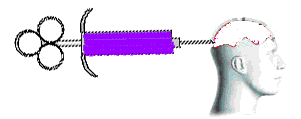In response to my post about 'understanding your audience' I have researched audience theories, which will allow me to understand their possible perceptions of my video, thus how allowing me to cater to their needs.
1. THE HYPODERMIC NEEDLE THEORY
Dating from the 1920s, this theory was the first attempt to explain how mass audiences might react to mass media. As you can see from the diagram, this theory suggests that audiences passively receive the information transmitted via a media text, without any attempt on their part to process or challenge the data. Governments had just discovered the power of advertising to communicate a message, and produced propaganda to try and sway populaces to their way of thinking. Basically, the Hypodermic Needle Theory suggests that the information from a text passes into the mass consciousness of the audience unmediated, ie the experience, intelligence and opinion of an individual are not relevant to the reception of the text. This theory suggests that, as an audience, we are manipulated by the creators of media texts, and that our behaviour and thinking might be easily changed by media-makers.
2. TWO-STEP FLOW
As the mass media became an essential part of life in societies around the world and did NOT reduce populations to a mass of unthinking drones, a more sophisticated explanation was sought. Paul Lazarsfeld, Bernard Berelson, and Hazel Gaudet analysed the voters' decision-making processes during a 1940 presidential election campaign and published their results in a paper called The People's Choice. Their findings suggested that the information does not flow directly from the text into the minds of its audience unmediated but is filtered through "opinion leaders" who then communicate it to their less active associates, over whom they have influence. The audience then mediate the information received directly from the media with the ideas and thoughts expressed by the opinion leaders, thus being influenced not by a direct process, but by a two step flow. This diminished the power of the media in the eyes of researchers, and caused them to conclude that social factors were also important in the way in which audiences interpreted texts.
3. USES & GRATIFICATIONS
Throughout time, it became increasingly apparent to media theorists that audiences made choices about what they did when consuming texts. Far from being a passive mass, audiences were made up of individuals who actively consumed texts for different reasons and in different ways.
In 1970, Halloran said, "We must get away from the habit of thinking in terms of what the media do to people and substitute for it the idea of what people do with the media." In other words, the consumer now has a say in what they want from the media.
C. Wright Mill decided the four functions of the media for the audience are:
- To give individuals identity
- To give people aspiration
- To give people instruction
- To give people a form of escapism
Researchers Blumler and Katz expanded this theory and published their own in 1974, stating that individuals might choose and use a text for the following purposes (ie uses and gratifications):
- Diversion - escape from everyday problems and routine.
- Personal Relationships - using the media for emotional and other interaction, eg) substituting soap operas for family life
- Personal Identity - finding yourself reflected in texts, learning behaviour and values from texts
- Surveillance - Information which could be useful for living eg) weather reports, financial news, holiday bargains
4. RECEPTION THEORY
Extending the concept of an active audience still further, in the 1980s and 1990s a lot of work was done on the way individuals received and interpreted a text, and how their individual circumstances (gender, class, age, ethnicity) affected their reading. This work was based on Stuart Hall's encoding/decoding model of the relationship between text and audience - the text is encoded by the producer, and decoded by the reader, and there may be major differences between two different readings of the same code. However, by using recognised codes and conventions, and by drawing upon audience expectations relating to aspects such as genre and use of stars, the producers can position the audience and thus create a certain amount of agreement on what the code means. This is known as a preferred reading.
When considering these theories, I will make sure I use recognised codes and conventions in my music video to grab my audience's attention. I know now that the codes I use will be interpreted differently, so I am expecting a mixture of opinions when my product is completed. I will also make sure I get audience feedback throughout the process so that I can give my target audience a product that they want.
How the emergence of new media is influencing the theory of mass audience that is not made clear by this account. Would any media theorists help me in this regard ?
ReplyDelete